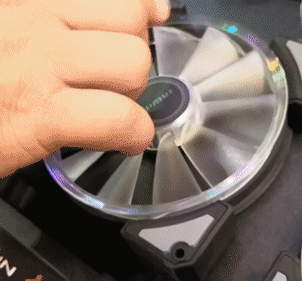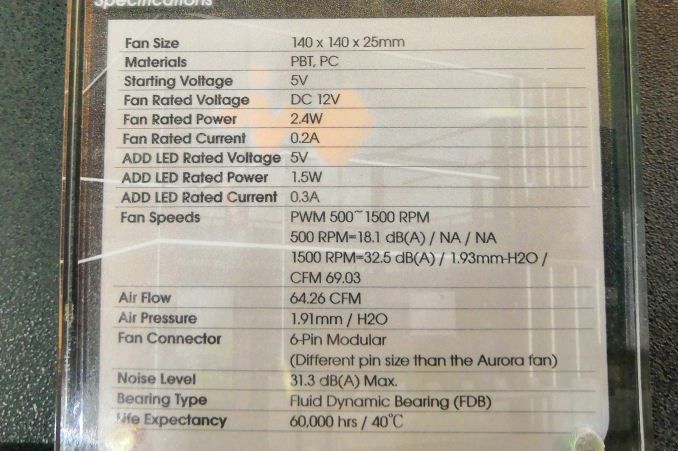The InWin Crown Fan: Why Bother with Closer Fan Blades When the Whole Fan Moves
by Ian Cutress on June 19, 2018 1:00 PM EST
In recent weeks and months, a lot of noise has been made about Noctua’s new fan design that uses precise tooling to create fan blades that are much closer to the edge of the fan than has been used previously. The benefits of such a design are often listed as a better and more powerful airflow. Well perhaps InWin just one-upped Noctua’s design, by fixing the blades to the fan sub-frame and spinning the sub-frame instead
This new fan design uses two main frame platforms: the first, which is fixed to the chassis in the corners, is used as a housing around the outside of the internal subframe as well as carrying the cables into the motor. The second is the subframe, which contains the fan blades fixed from the center to the sub-frame. The end result is that almost the whole fan spins around.
There are pros and cons to this method, including the fan blades getting more air and having more of the sub-frame move can assist with shifting air. The downside is that there is more mass, so the total RPM of the fan (at equal torque) is likely to be lower.
InWin rates these fans at 2.4W, with an average airflow of 64.26 cubic feet per minute, and an average air pressure of 1.91 mmH2O, with a noise level of 31.3 dB(A). The motor is a fluid dynamic bearing and rated for 60,000 hours use. At retail a twin pack of 140mm fans should come in under $60, and 120mm fans are available also.
| Want to keep up to date with all of our Computex 2018 Coverage? | ||||||
 Laptops |
 Hardware |
 Chips |
||||
| Follow AnandTech's breaking news here! | ||||||














35 Comments
View All Comments
BurntMyBacon - Wednesday, June 20, 2018 - link
@Alexvrb: "I'd be more interested in bearing longevity and noise over time. A good Noctua is rated at 150K hours and has a 6 year warranty."Blacknoise Technologies makes some Noise Blocker eLoop fans that function similarly to these. They have a 6 year warranty and are rated from 120K to 160K depending on RPMs. That said, my first batch of eLoops didn't live up to these expectations. Second batch and beyond are holding up fine though. The question is how good Inwin's quality is relative to the eLoops.
Alexvrb - Thursday, June 21, 2018 - link
Interesting. On paper though looking through the specs for their eLoop B14-PS 140mm PWM fan, it has similar airflow and noise as Noctua's NF-A14 PWM, but inferior static pressure. That limits it to case fans, and even then sometimes I have more intake fans than exhaust ones so the extra pressure might still come in handy.Seems like good product overall though, poking around.
gopjer11 - Tuesday, June 19, 2018 - link
These types of blade sealing are more efficient from an aerodynamic point of view. So, less torque and power for a given flow / pressure. Power problems may well arise from bearing loads though, especially if their FDB is under a higher / asymmetric load (more likely with higher edge mass). If their bearing is operating within spec. it should still be more efficient overall.Spunjji - Wednesday, June 20, 2018 - link
Trust me, this is cheaper to do than what Noctua have done. They haven't done it because designs like this have already been tried and they always result in inferior performance due to increased load on the bearings.BurntMyBacon - Wednesday, June 20, 2018 - link
You mean designs like this:http://www.blacknoise.com/site/en/products/noisebl...
I've used these. My first batch wasn't quite as reliable as I'd hoped, but the performance was certainly not inferior. Second batch and beyond seems to be holding up fine.
gopjer11 - Tuesday, June 19, 2018 - link
They don't because the spinning mass will upset the acoustics. The fundamental tone will be a major issue for this fan, due to the unbalanced aspect - either emitting airbourne or worse propagating through the case. If it was properly balanced (phase / single) it could be very quiet, but thats much more $$$ !Hereiam2005 - Tuesday, June 19, 2018 - link
Uh, because this is dumb?A rotating frame has excessive drag due to the huge amount of surface area at maximum speed without contributing to actual airflow.
So you might get some air pressure advantage at a huge cost of power consumption and some additional turbulence. I'd wait for review but might not be worth it.
Spunjji - Wednesday, June 20, 2018 - link
This. It's definitely not worth it!BurntMyBacon - Wednesday, June 20, 2018 - link
@megadirk: "The real question is, if this was the optimal design for static pressure why wouldn't a company like Noctua have released something like this already? Instead of trying to get their blades as close the edge as possible like with their new release."I submit for your consideration:
http://www.blacknoise.com/site/en/products/noisebl...
They are, perhaps, not as well known as Noctua, but not an unknown entity either. They are pretty well regarded AFAIK.
umano - Sunday, June 24, 2018 - link
It seems it's not, the a15 pwn from noctua generates 115,5 m³/h at 1200 rpm with 19,2 db(a) while this one 113,83 (64.24 CFM) or 117,7 (69.03 CFM in the picture) at 1500 rpm with 31.3 db(a). But noctua has less static pressure on the 1200 rpm, while the 1500 rpm one, 140 m³/h, 2.08 mm and 24.6 db(a). At least on paper I don't see any improvments